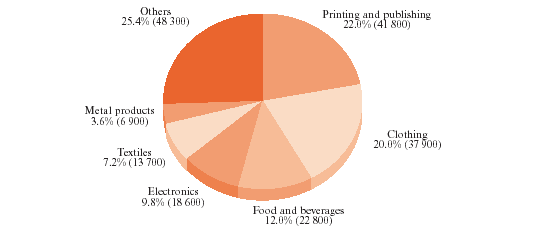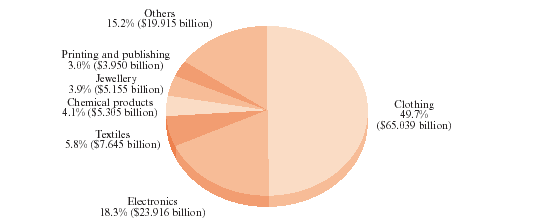Innovation, technology and relocation of lower value-added operations to the Mainland have accelerated the development of more knowledge-based and higher value-added manufacturing activities, as well as manufacturing-related services or producer services. Expansion of manufacturing activities offshore since the 1980s has turned Hong Kong into a strategic control centre of an increasingly globalised production network. In spite of the economic restructuring, the manufacturing sector remained an important sector of the economy, providing employment to 184 503 persons (8.2 per cent of the total private sector employees) in December 2002.
The printing and publishing industry was the largest employer in the manufacturing sector in 2002, followed by the clothing industry. Chart 1 shows the breakdown of employment within the manufacturing sector in 2002.
| Chart 1: Number of Persons Employed by the Manufacturing Sector in 2002* | |
 |
|
| *As at September | |
The manufacturing sector remains export-oriented and its excellent performance contributed to Hong Kong's ranking as one of the world's leading exporters of textiles, clothing, watches and clocks, toys and jewellery. Domestic exports amounted to $131 billion in 2002 with clothing, electronics, textiles, chemical products and jewellery being the major export items. Chart 2 shows the value breakdown of domestic exports in 2002.
| Chart 2: Value of Domestic Exports of the Manufacturing Sector in 2002* | |
 |
|
| *As at September | |
The manufacturing sector is dominated by small and medium enterprises (SMEs). Of the 19 106 manufacturing establishments in 2002, 18 865 (98.74 per cent) employed fewer than 100 persons, accounting for 63.26 per cent of Hong Kong's total manufacturing employment. Many SMEs are linked with larger factories through an efficient and flexible sub-contracting network. This arrangement has enabled the manufacturing sector to respond swiftly to market changes.